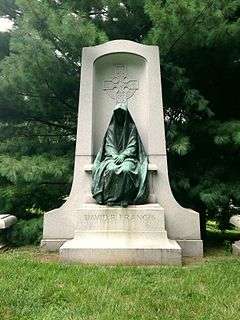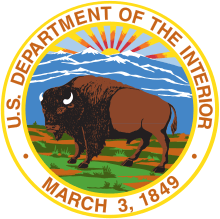David R. Francis
David Rowland Francis (October 1, 1850 – January 15, 1927) was an American politician and diplomat. He served in various positions including Mayor of St. Louis, the 27th Governor of Missouri, and United States Secretary of the Interior. He was the U.S. Ambassador to Russia between 1916 and 1917, during the Russian Revolution of 1917. He was a Wilsonian Democrat.[1]
David Francis | |
|---|---|
 | |
| United States Ambassador to Russia | |
| In office May 5, 1916 – November 7, 1917 | |
| President | Woodrow Wilson |
| Preceded by | George Marye |
| Succeeded by | William Christian Bullitt Jr. (Soviet Union) |
| President of the Organising Committee for the Olympic Games | |
| In office October 28, 1900 – September 3, 1904 | |
| President | Pierre de Coubertin |
| Preceded by | Pierre de Coubertin |
| Succeeded by | Edward Battell |
| 20th United States Secretary of the Interior | |
| In office September 3, 1896 – March 5, 1897 | |
| President | Grover Cleveland William McKinley |
| Preceded by | Hoke Smith |
| Succeeded by | Cornelius Bliss |
| 27th Governor of Missouri | |
| In office January 14, 1889 – January 9, 1893 | |
| Lieutenant | Stephen Claycomb |
| Preceded by | Albert P. Morehouse |
| Succeeded by | William J. Stone |
| 26th Mayor of St. Louis | |
| In office April 14, 1885 – January 2, 1889 | |
| Preceded by | William L. Ewing |
| Succeeded by | Edward A. Noonan |
| Personal details | |
| Born | David Rowland Francis October 1, 1850 Richmond, Kentucky, U.S. |
| Died | January 15, 1927 (aged 76) St. Louis, Missouri, U.S. |
| Resting place | Bellefontaine Cemetery |
| Political party | Democratic |
| Spouse(s) | Jane Perry (m. 1876; her death 1924) |
| Children | 6 |
| Education | Washington University (BA) |
Early life
Francis was born on October 1, 1850 in Richmond, Kentucky, the son of Eliza Caldwell (née Rowland) (1830–1898) and John Broaddus Francis (1818–1894).[1] He graduated from Washington University in St. Louis in 1870 where he was number one on the rolls of the Alpha Iota chapter of Beta Theta Pi fraternity.[1]
Career
After graduating from University, he became a successful businessman in St. Louis and served as the president of a grain merchant's exchange.[1] The St. Louis Mining and Stock Exchange was formed in St. Louis in the fall of 1880 with Francis as a founding member.[2]
In 1885, he was elected Mayor of St. Louis, Missouri as a Democrat. In 1888, he was elected Governor of Missouri becoming the only Mayor of St. Louis elected Governor of the state.
In 1896, Francis was appointed United States Secretary of the Interior by President Grover Cleveland and served until 1897.
World's Fair 1904
Francis was one of the main promoters of the St. Louis World's Fair of 1904, serving as President of the Louisiana Purchase Exposition. Historians generally emphasize the prominence of themes of race and empire, and the Fair's long-lasting impact on intellectuals in the fields of history, art history, architecture and anthropology. From the point of view of the memory of the average person who attended the fair, it primarily promoted entertainment, consumer goods and popular culture.[3]
The 1904 Summer Olympics were held in combination with that Exposition, and by overseeing the opening ceremony, Francis became the only American to open an Olympic Games who never served as President or Vice-President of the United States.
Later career
In 1905, after being elected President of the Louisiana Purchase Exposition Company, he was sent to Europe by the World's Fair directors to thank kings, emperors and other rulers for their part in making the exposition a success. He was decorated by the emperors of Germany and Austria[4] and Wilhelmina, the Queen of the Netherlands.[1]
In 1910, Francis was arrested for non-payment of taxes, but released on bail.[5]
Diplomatic career
.jpg)
President Woodrow Wilson appointed Francis as the last U.S. Ambassador to the Russian Empire between 1916 and 1917.[6][7] During his time as ambassador, he was almost appointed as U.S. Senator from Missouri.[8] He served in that post during the Russian Revolution of 1917.[9][10]
Francis was the final owner of the St. Louis Republic, a morning newspaper which he sold after years of losses to the rival St. Louis Globe-Democrat in 1919. His biographer, Harper Barnes, summarized his personality:
David R. Francis was a brash, opinionated, stubborn, smart, sometimes foolish, straight-talking, quick-acting, independent-minded, proud, self-made man who represented the United States in Russia for two and a half years, during the most tumultuous era in that country's history. Much of his activity has been shrouded in myth – some of that heroic, more of that comic and tragic.[11]
Personal life
On January 20, 1876, he married the former Jane Perry (1854–1924), the daughter of John Dietz Perry (1815–1895) and a granddaughter of James Earickson, the former Missouri State Treasurer.[12] They had six children: John David Perry (1876–1950), David Rowland, Jr. (1879–1938), Charles Broaddus (1881–1957), Talton Turner (1882–1955), Thomas (1884–1964), and Sidney Rowland Francis (1888–1960).
His wife died in San Antonio, Texas on March 21, 1924. Francis died in St. Louis, Missouri, on January 15, 1927. He was buried in Bellefontaine Cemetery.[1]
Legacy


In 1895, the University of Missouri dedicated David R. Francis Quadrangle in honor of the former governor who is credited with keeping the university in Columbia after the fire of Academic Hall in 1892. Francis insisted that the state's land-grant university remain in a central location, rather than moving to Sedalia, as many state legislators desired. Instead, Sedalia was awarded the Missouri State Fair as compensation. A bronze bust of Francis' face sits at the south end of Francis Quad near the steps of Jesse Hall. A popular MU student tradition is to rub Governor Francis' nose before taking a test in order to get an A.
The track/soccer/football stadium at Washington University in St. Louis, as well as the adjacent gymnasium, are named in Francis' honor. Francis Field was the site of the 1904 Summer Olympics; Francis attended the opening ceremony and officially opened the games as the representative for the host nation.
In 1916, he gave 60 acres (240,000 m2) of land to the city of St. Louis, Missouri as a Christmas gift. It was turned into a park that bears his name.[13]
References
Notes
- "D. R. FRANCIS DEAD; EX-AMBASSADOR; Was in Russia When Kerensky Deposed Czar, Also When "Reds" Seized Power. EX-SECRETARY OF INTERIOR Served Missouri as Governor and St. Louis as Mayor -- Headed the 1904 World's Fair". The New York Times. 16 January 1927. Retrieved 13 July 2017.
- Thomas Scharf, John, History of Saint Louis City and County: From the Earliest Periods ..., Volume 2, retrieved September 24, 2017
- James Gilbert, Whose Fair? Experience, and Memory, and the History of the Great St. Louis Exposition (2009)
- "Austrian Honor for David R. Francis". The New York Times. 24 June 1905. Retrieved 13 July 2017.
- Gov. Francis Gives $200 Bail, at the Tacoma Times (via Chronicling America); published March 12, 1910; retrieved April 14, 2014
- Times, Special To The New York (23 February 1916). "FRANCIS GOING TO RUSSIA.; Missouri Ex-Governor Accepts Appointment as Ambassador". The New York Times. Retrieved 13 July 2017.
- Times, Special Cable To The New York (20 July 1917). "FRANCIS ESCAPES PLOT TO KILL HIM; Attempt Made in Finland to Blow Up Train on Which Ambassador Was Traveling". The New York Times. Retrieved 13 July 2017.
- "BARS NAMING FRANCIS.; Lansing's Objection Prevents Appointment of Ambassador as Senator". The New York Times. 24 April 1918. Retrieved 13 July 2017.
- "Francis Warns Russians of Danger in Separate Peace". The New York Times. 14 January 1918. Retrieved 13 July 2017.
- "Ex-Ambassador Francis Describes the Russian Revolution". The New York Times. 21 August 1921. Retrieved 13 July 2017.
- Harper Barnes (2001). Standing on a Volcano: The Life and Times of David Rowland Francis. Missouri History Museum. p. 11.
- Missouri State Treasurer-Past Treasurers Biography
- http://stlouis.missouri.org/citygov/parks/parks_div/Francis.html
Sources
- "Installed". St. Louis Post-Dispatch. 14 April 1885. p. 2.
- "The City Hall Change". St. Louis Post-Dispatch. 2 January 1889. p. 10.
- Francis, David Rowland. The universal exposition of 1904. (Louisiana purchase exposition Company, 1913). online
- Francis, David Rowland. Russia from the American Embassy, April, 1916-November, 1918 (C. Scribner's Sons, 1921).
- Francis, David Rowland, and Jamie H. Cockfield. (1981). Dollars and diplomacy: Ambassador David Rowland Francis and the fall of tsarism, 1916-17 (Durham: Duke University Press).
- Francis, David Rowland, Robert Chadwell Williams, and Robert Lester. (1986). Russia in transition: the diplomatic papers of David R. Francis, U.S. Ambassador to Russia, 1916-1918 (Frederick, Md: University Publications of America).
Further reading
- Barnes, Harper. (2001). Standing on a volcano: the life and times of David Rowland Francis (St. Louis: Missouri Historical Society Press in association with the Francis Press. ISBN 1-883982-13-8).
External links
| Wikimedia Commons has media related to David R. Francis. |
| Wikisource has original works written by or about: David R. Francis |
- David R. Francis at St. Louis Public Library: St. Louis Mayors.
- Standing on a Volcano: The Life and Times of David R. Francis by Harper Barnes, October 2001. ISBN 1-883982-17-0.
- Missouri State Archives. David Rowland Francis, 1889-1893
| Political offices | ||
|---|---|---|
| Preceded by William L. Ewing |
Mayor of St. Louis 1885–1889 |
Succeeded by Edward A. Noonan |
| Preceded by Albert P. Morehouse |
Governor of Missouri 1889–1893 |
Succeeded by William J. Stone |
| Preceded by Hoke Smith |
United States Secretary of the Interior 1896–1897 |
Succeeded by Cornelius Bliss |
| Party political offices | ||
| Preceded by John S. Marmaduke |
Democratic nominee for Governor of Missouri 1888 |
Succeeded by William J. Stone |
| Diplomatic posts | ||
| Preceded by George Marye |
United States Ambassador to Russia 1916–1917 |
Succeeded by William Christian Bullitt Jr. as United States Ambassador to the Soviet Union |


